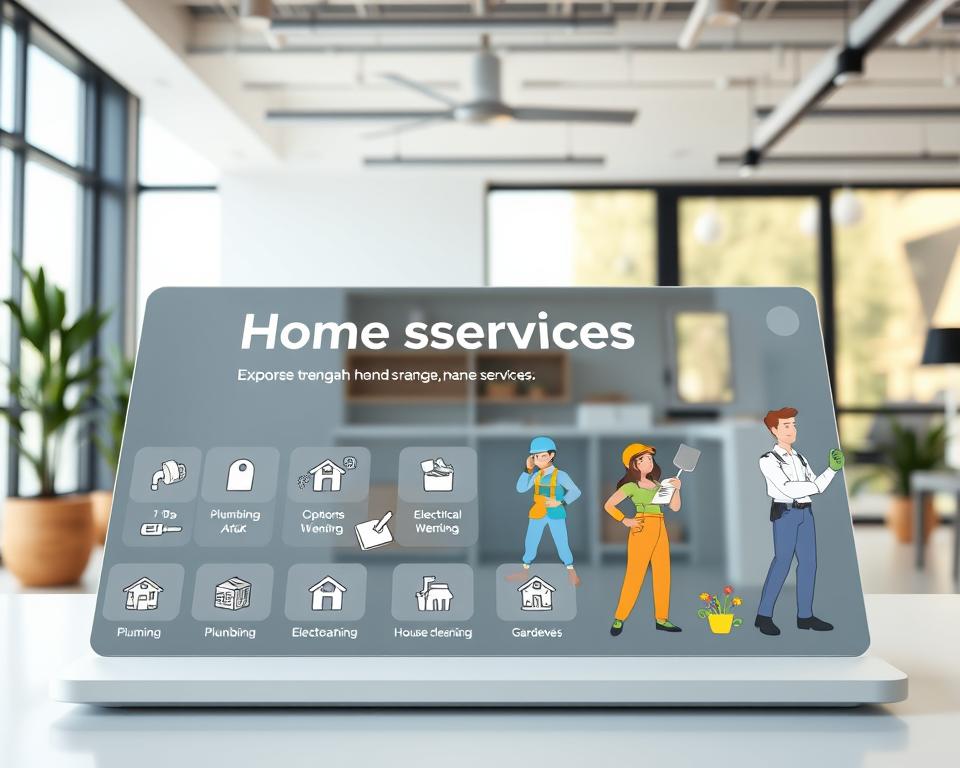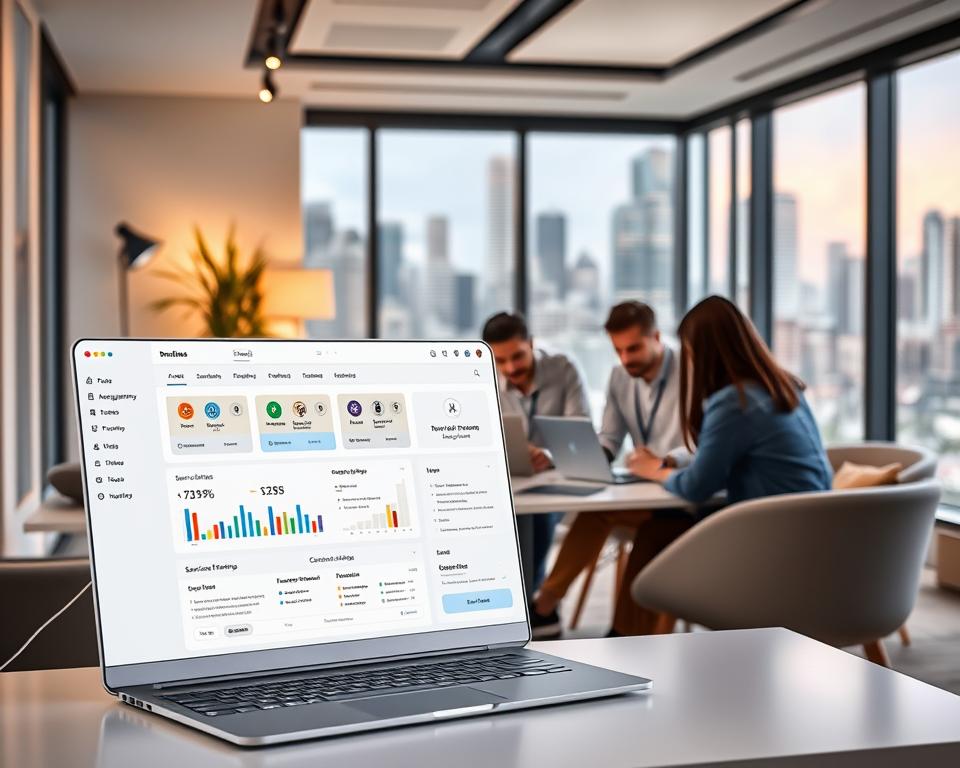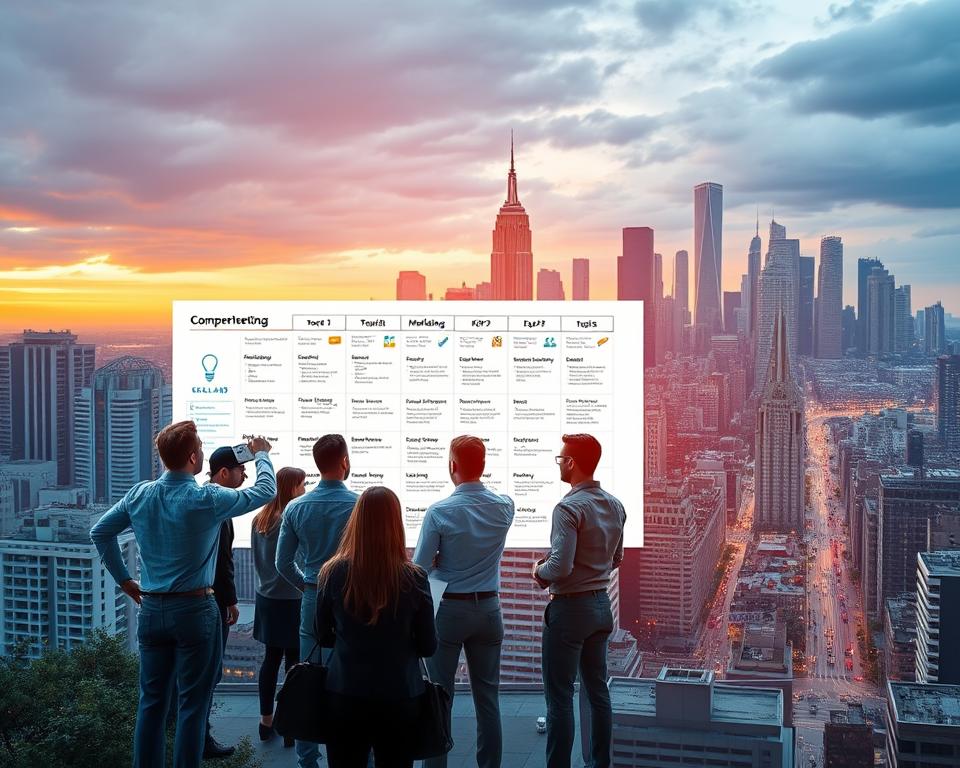To create a successful on-demand home services portal like Thumbtack, you need to know the market well. The on-demand home services market is booming, with Thumbtack leading the way. Such a portal connects people with professionals for various home services.
A platform like Thumbtack makes it easy for customers to find and book services. To make a successful platform, understanding the market size and growth is key.
Table of Contents
Introduction to On-Demand Home Services
Knowing the on-demand home services market is vital for a successful portal. The market is big and growing, offering chances for new platforms to start.
Key Takeaways
- Understand the on-demand home services market and target audience
- Develop a user-friendly home services portal
- Conduct market research to understand the current market size and growth potential
- Identify key players in the industry and market opportunities
- Build a platform with core features that meet customer needs
- Ensure a seamless user experience for customers and service providers
Understanding the On-Demand Home Services Market
The on-demand home services market is booming. It’s all about convenience and flexibility. Knowing the market well is key to success.
Studies show the market will hit $1,574.4 billion by 2027. It’s growing at 41.8% each year. This growth potential is a chance for new ideas and changes.
Big names like Thumbtack, TaskRabbit, and Handy are already big players. But, there’s room for new ones to shine. The market size is huge, and more people want these services. They want things done easily and quickly.
- More people want things done easily and quickly.
- More people live in cities and have busy lives.
- New tech and digital platforms help a lot.
Knowing these points and the market size and growth potential is crucial. Businesses can offer new solutions. They can meet the changing needs of people in the on-demand home services market.
Core Features of a Successful Home Services Platform
A top-notch home services platform needs solid core features for a smooth experience. It should have service provider management, payment options, user reviews, and scheduling tools. This setup lets customers easily find and book services. It also gives service providers the tools to run their businesses well.
Some key features of a home services platform include:
- Service provider management: This feature helps manage and check service providers. It ensures customers get reliable and trustworthy professionals.
- Payment processing: A safe payment system is key. It lets customers pay for services easily and securely.
- User review systems: This feature lets customers review and rate service providers. It builds trust and credibility within the platform.
By adding these core features to a home services platform, businesses can offer a seamless experience. This boosts customer satisfaction, builds trust, and drives growth. The service provider management system is crucial. It makes sure service providers are reliable, trustworthy, and offer quality services.
In summary, a well-designed home services platform with strong core features can change how customers find and book services. It also gives service providers the tools to succeed. By focusing on service provider management and other key features, businesses can create a platform that’s both easy to use and effective.
Essential Technology Stack for Building a Home Services Portal Like Thumbtack
Building a home services portal like Thumbtack needs a strong technology stack. This includes frontend development tools, backend infrastructure, database systems, and third-party integrations. A good technology stack makes the user experience smooth, service delivery efficient, and the platform scalable.
The choice of frontend development tools, like React or Angular, depends on the user interface and experience you want. For backend infrastructure, Node.js or Ruby on Rails are good choices. They handle requests, process data, and connect with databases well.
- Database management systems, such as MySQL or MongoDB, to store and manage user data, service provider information, and booking details
- Third-party integrations, like payment gateways and mapping services, to enhance the user experience and provide additional functionality
- A robust technology stack that supports frontend development and backend infrastructure to ensure a scalable and efficient platform
By carefully choosing and integrating these components, developers can build a comprehensive and user-friendly home services portal. It meets the needs of both customers and service providers. This is made possible by the power of technology stack, frontend development, and backend infrastructure.
User Experience Design Considerations
A well-designed user experience is key for a home services platform’s success. With 75% of users judging a website’s credibility by its look, focusing on user experience design is vital. It’s about making the interface easy to use, navigation clear, and the flow smooth. This way, customers can easily find and book services.
Good UX and UI design can greatly help keep customers and grow your business. A platform should be clean, simple, and easy to use. It should also work well on all devices and screen sizes. This approach ensures a positive user Soap experience that encourages repeat visits.
Important aspects of user experience design include:
- Simple and intuitive navigation
- Clear and concise language
- Prominent calls-to-action
- Responsive design for different devices and screen sizes
By focusing on user experience design and these key points, you can make a home services platform that works well and is easy to use. This builds trust with customers, drives growth, and keeps you competitive.
Service Provider Management System
Effective service provider management is key for any on-demand home services platform. It covers verification, onboarding, profile management, and rating systems. A good system ensures quality services for customers and protects service providers’ interests.
Verification and Onboarding Process
The verification and onboarding process is vital. It checks service providers’ identity and qualifications. It also makes sure they know the platform’s rules. A smooth onboarding helps service providers start quickly and avoid mistakes.
Profile Management Features
Profile management lets service providers update their info and services. This helps customers find the right service. It also lets service providers show off their skills.
Rating and Review System
A rating and review system lets customers share their experiences. This helps service providers improve. It also makes customers trust the platform more. By adding these features, platforms can make everyone happy, leading to growth.
- Verification and onboarding process
- Profile management features
- Rating and review system
A comprehensive service provider management system is essential. It ensures quality and reliability. It also protects service providers. This builds trust with customers, leading to success.
Payment Gateway Integration and Processing
Building a home services platform needs a payment gateway for secure and easy transactions. The payment gateway must be safe, fast, and grow with your business. It should support features like tokenization, encryption, and recurring payments.
Payment gateway integration is key for a smooth processing experience. Choose a gateway that offers many payment ways, like credit and debit cards, and online payments.
Important things to think about when integrating a payment gateway include:
- Security: It must protect customer data well.
- Scalability: It should handle lots of transactions, perfect for big platforms.
- Flexibility: It should have various payment options for different needs.
Adding a payment gateway makes processing easier and improves customer happiness. This can boost loyalty and increase your earnings.
Building the Customer-facing Mobile Application
A mobile app is key for a smooth user experience and more customer interaction. By making apps for both iOS and Android, companies can reach more people. A study by Next Big Technology shows how important it is to design apps that connect users with experts.
Creating an iOS app means thinking about technical requirements like push notifications. Android apps need location-based services and other special features. Companies should think about their audience and the devices they use when choosing between iOS and Android.
- Push notifications to keep users informed
- In-app messaging for seamless communication
- Location-based services to provide personalized experiences
By adding these features and making apps for both iOS and Android, companies can offer a great experience to their customers.
Security Measures and Compliance Requirements
Building a home services platform means you must protect user data. It’s key to follow security measures and compliance rules like GDPR and CCPA. This keeps users’ trust and avoids legal trouble.
The platform needs strong security measures like encryption and firewalls. These steps prevent unauthorized data access. They also make sure the platform follows the law. For more on security measures in home services platforms, check out on-demand home services apps.
Important security measures and compliance points include:
- Using strong encryption to safeguard user data
- Doing regular security checks to find weak spots
- Following laws like GDPR and CCPA
By focusing on security measures and compliance, a home services platform keeps user data safe. This gives it a strong position in the market.
Marketing and User Acquisition Strategies
To succeed in the home services market, a strong marketing plan is key. It’s about using digital channels to find both customers and service providers. TaskRabbit and Thumbtack show how effective marketing can make a big difference.
Digital marketing plays a big role here. It includes SEO, pay-per-click ads, and social media. These tools help a platform get noticed, bring in more visitors, and get more leads. For example, a platform can use digital marketing to reach the right people and highlight its services.
- Offering incentives to new users, such as discounts or promotions
- Utilizing referral programs to encourage word-of-mouth marketing
- Partnering with local businesses to expand the platform’s reach
By focusing onuser acquisitionandmarketing, home services platforms can grow their user base. This growth leads to more revenue and success.
Monetization Models and Revenue Streams
A home services platform needs a strong monetization model and revenue stream to thrive. It can use commission-based models, where it gets a share of the service cost. Or, it can opt for subscription-based models, where users pay a regular fee for premium services. For more on building a successful platform, check out home rental app development guides.
Some common monetization models and revenue streams for home services platforms include:
- Commission-based models
- Subscription-based models
- Advertising-based models
These models can be used alone or together to build a strong revenue stream for the platform.
When picking a monetization model, think about your target audience, services, and competition. By choosing the right revenue stream, a home services platform can stay profitable and successful in the long run.
Scaling Your Platform: Infrastructure and Performance
As a home services platform grows, it’s key to focus on scaling. This ensures a strong infrastructure and top-notch performance. It’s important to use cloud services, load balancing, and database optimization to handle more traffic and users.
A solid infrastructure is crucial for a home services platform’s growth. Cloud services from Amazon Web Services or Microsoft Azure help platforms scale up or down. This boosts performance and cuts down on downtime and data loss risks. For more on building a scalable platform, check out this resource.
To boost performance, use load balancing to spread traffic across servers. This keeps servers from getting too busy, leading to faster response times and a better user experience. Also, optimize databases with indexing and caching to speed up queries and enhance performance.
Important points for scaling a home services platform include:
- Set up automated scaling to cut down on manual work
- Keep an eye on system performance to find and fix issues
- Use load balancing to evenly distribute traffic
Maintenance and Support Systems
A home services platform needs a strong maintenance and support system. This ensures it stays stable and secure. It’s important to offer great customer service, technical support, and keep users updated.
Some important things to think about for maintenance and support are:
- Regular software updates and patches to prevent bugs and security vulnerabilities
- A reliable customer service team to handle user inquiries and issues
- A comprehensive knowledge base and FAQ section to provide users with easy access to information
By focusing on maintenance and support, a home services platform can earn a good reputation. It also keeps a loyal user base. As the platform grows, it’s key to keep investing in customer service and technical support. This makes sure the platform stays stable, secure, and easy to use.
Conclusion
Building a successful home services platform like Thumbtack needs a detailed plan. It includes market analysis, tech advancements, user experience, and ongoing support. By understanding what customers and service providers need, you can build a platform that meets their needs.
The demand for on-demand home services is rising. Success comes from using the latest tech, focusing on users, and having a strong network of professionals. By following this guide, you can start a home services platform that stands out for its convenience and reliability.
The future of home services is full of chances. By being innovative and flexible, your platform can become a go-to for quality home services. With a focus on excellence and a deep knowledge of the industry, you can make a big difference in people’s lives.
FAQ
What is the current market size and growth potential of the on-demand home services industry?
What is the current market size and growth potential of the on-demand home services industry?
FAQ
What is the current market size and growth potential of the on-demand home services industry?
The on-demand home services market is booming. It’s expected to hit
FAQ
What is the current market size and growth potential of the on-demand home services industry?
The on-demand home services market is booming. It’s expected to hit $1,574.4 billion by 2027. This growth is at a rate of 41.8% from 2020 to 2027.
Who are the key players in the on-demand home services industry?
Key players include Thumbtack, TaskRabbit, and Handy. They are leaders in the field.
What are the core features of a successful home services platform?
A good platform should manage service providers and handle payments. It should also have user reviews and scheduling tools. This ensures a smooth experience for everyone.
What is the essential technology stack for building a home services portal like Thumbtack?
Building a platform like Thumbtack needs a strong tech stack. This includes React or Angular for the frontend and Node.js or Ruby on Rails for the backend. You’ll also need a database like MySQL or MongoDB and third-party integrations.
What are the key user experience design considerations for a home services platform?
Good design is crucial. The platform should have an easy-to-use interface and clear navigation. A smooth user flow is also key, as 75% of users judge a site’s credibility by its look.
What are the essential features of a service provider management system?
A service provider system should verify and onboard providers. It should also manage their profiles and handle ratings and reviews. This ensures quality and reliability.
What are the key considerations for payment gateway integration and processing?
Payment integration must be secure and efficient. It should support tokenization, encryption, and recurring payments. This makes transactions safe and easy.
What are the important aspects of building a customer-facing mobile application?
A mobile app is vital for a good user experience. It should work on both iOS and Android. Features like push notifications and location-based services are also important.
What are the essential security measures and compliance requirements for a home services platform?
The platform must have strong security measures. This includes encryption, firewalls, and access controls. It should also follow regulations like GDPR and CCPA to protect user data.
What are the key marketing and user acquisition strategies for a home services platform?
A solid marketing strategy is essential. It should include digital marketing, SEO, and ways to keep users engaged. This attracts and keeps customers.
What are the important monetization models and revenue streams for a home services platform?
The platform needs a strong monetization model. This could be commission-based, subscription-based, or advertising-based. It’s important for the platform’s financial health.
How can a home services platform be scaled effectively?
Scaling requires a solid infrastructure. This includes cloud services, load balancing, and database optimization. It ensures the platform is stable and can grow.
What are the essential maintenance and support systems for a home services platform?
The platform needs a good maintenance and support system. This includes customer service, technical support, and regular updates. It keeps the platform stable and secure.
,574.4 billion by 2027. This growth is at a rate of 41.8% from 2020 to 2027.
Who are the key players in the on-demand home services industry?
Key players include Thumbtack, TaskRabbit, and Handy. They are leaders in the field.
What are the core features of a successful home services platform?
A good platform should manage service providers and handle payments. It should also have user reviews and scheduling tools. This ensures a smooth experience for everyone.
What is the essential technology stack for building a home services portal like Thumbtack?
Building a platform like Thumbtack needs a strong tech stack. This includes React or Angular for the frontend and Node.js or Ruby on Rails for the backend. You’ll also need a database like MySQL or MongoDB and third-party integrations.
What are the key user experience design considerations for a home services platform?
Good design is crucial. The platform should have an easy-to-use interface and clear navigation. A smooth user flow is also key, as 75% of users judge a site’s credibility by its look.
What are the essential features of a service provider management system?
A service provider system should verify and onboard providers. It should also manage their profiles and handle ratings and reviews. This ensures quality and reliability.
What are the key considerations for payment gateway integration and processing?
Payment integration must be secure and efficient. It should support tokenization, encryption, and recurring payments. This makes transactions safe and easy.
What are the important aspects of building a customer-facing mobile application?
A mobile app is vital for a good user experience. It should work on both iOS and Android. Features like push notifications and location-based services are also important.
What are the essential security measures and compliance requirements for a home services platform?
The platform must have strong security measures. This includes encryption, firewalls, and access controls. It should also follow regulations like GDPR and CCPA to protect user data.
What are the key marketing and user acquisition strategies for a home services platform?
A solid marketing strategy is essential. It should include digital marketing, SEO, and ways to keep users engaged. This attracts and keeps customers.
What are the important monetization models and revenue streams for a home services platform?
The platform needs a strong monetization model. This could be commission-based, subscription-based, or advertising-based. It’s important for the platform’s financial health.
How can a home services platform be scaled effectively?
Scaling requires a solid infrastructure. This includes cloud services, load balancing, and database optimization. It ensures the platform is stable and can grow.
What are the essential maintenance and support systems for a home services platform?
The platform needs a good maintenance and support system. This includes customer service, technical support, and regular updates. It keeps the platform stable and secure.



















